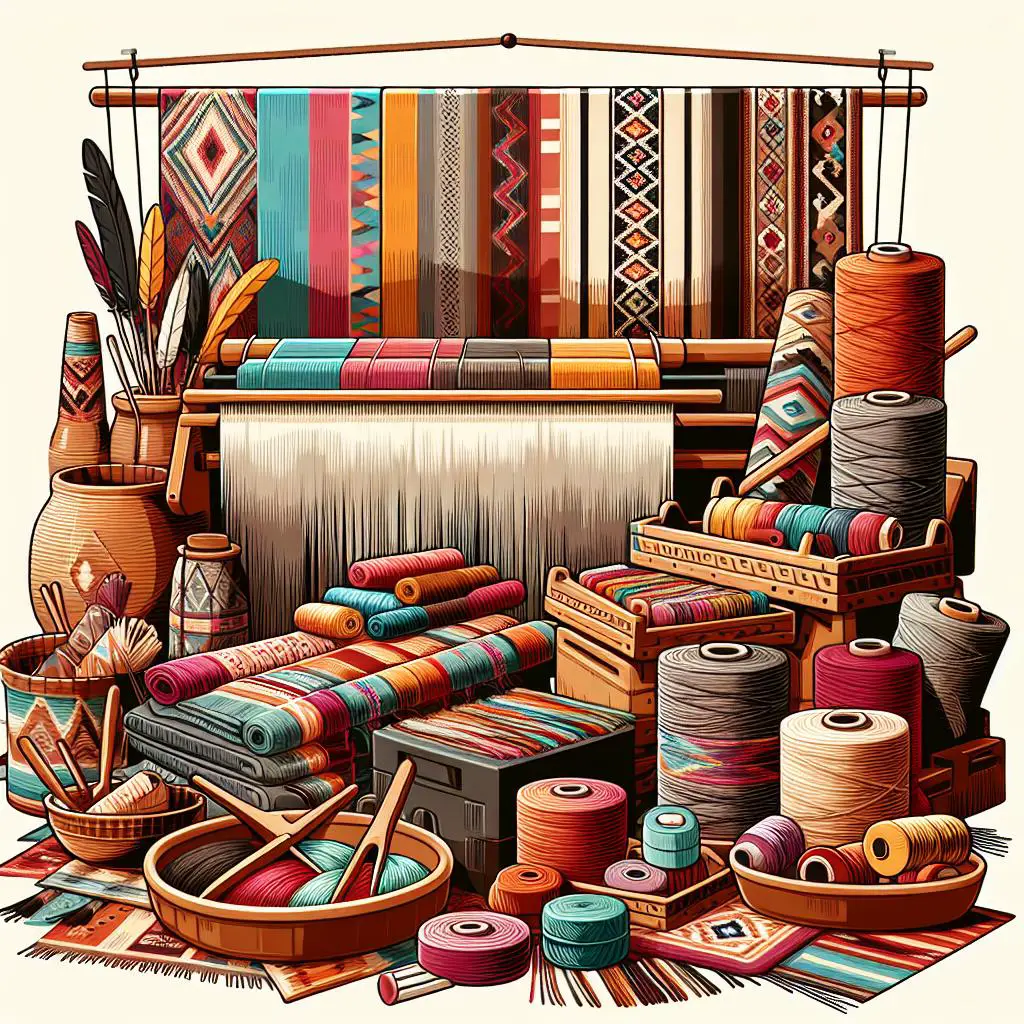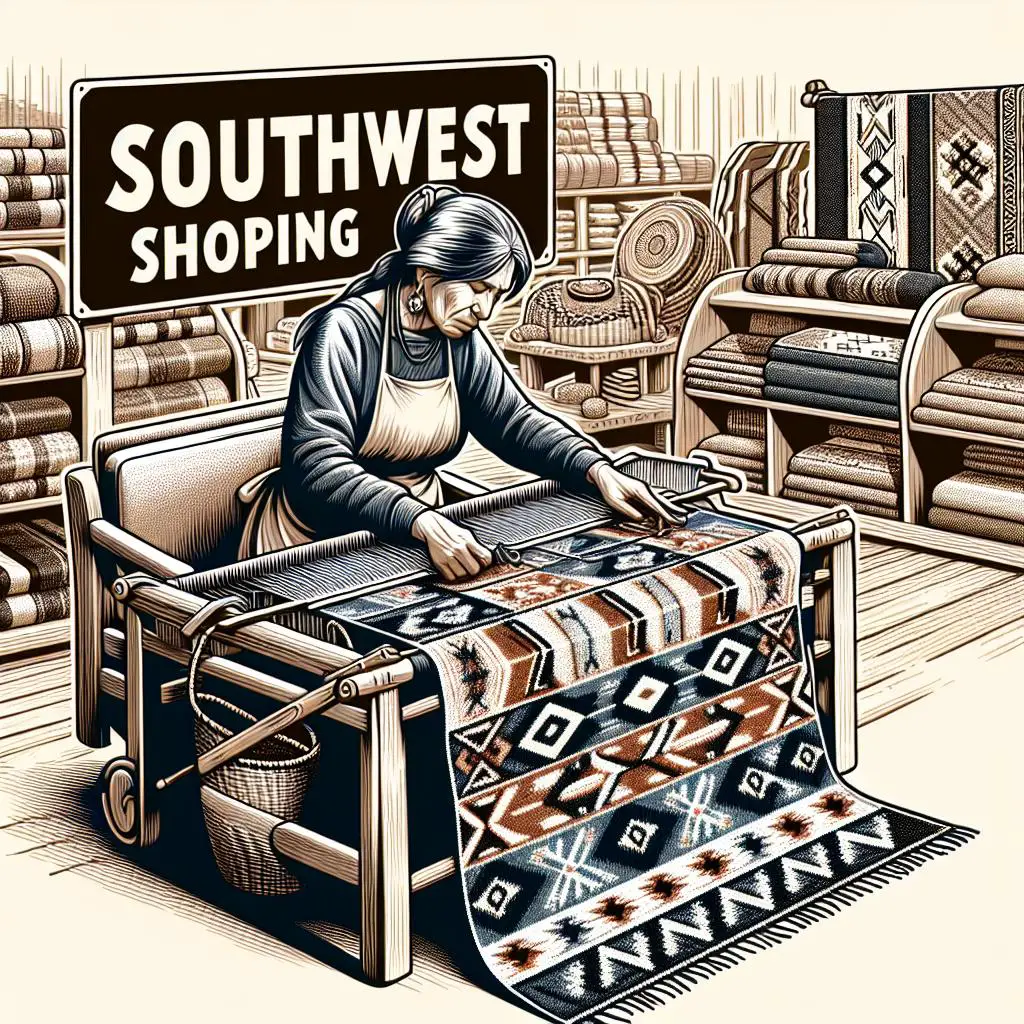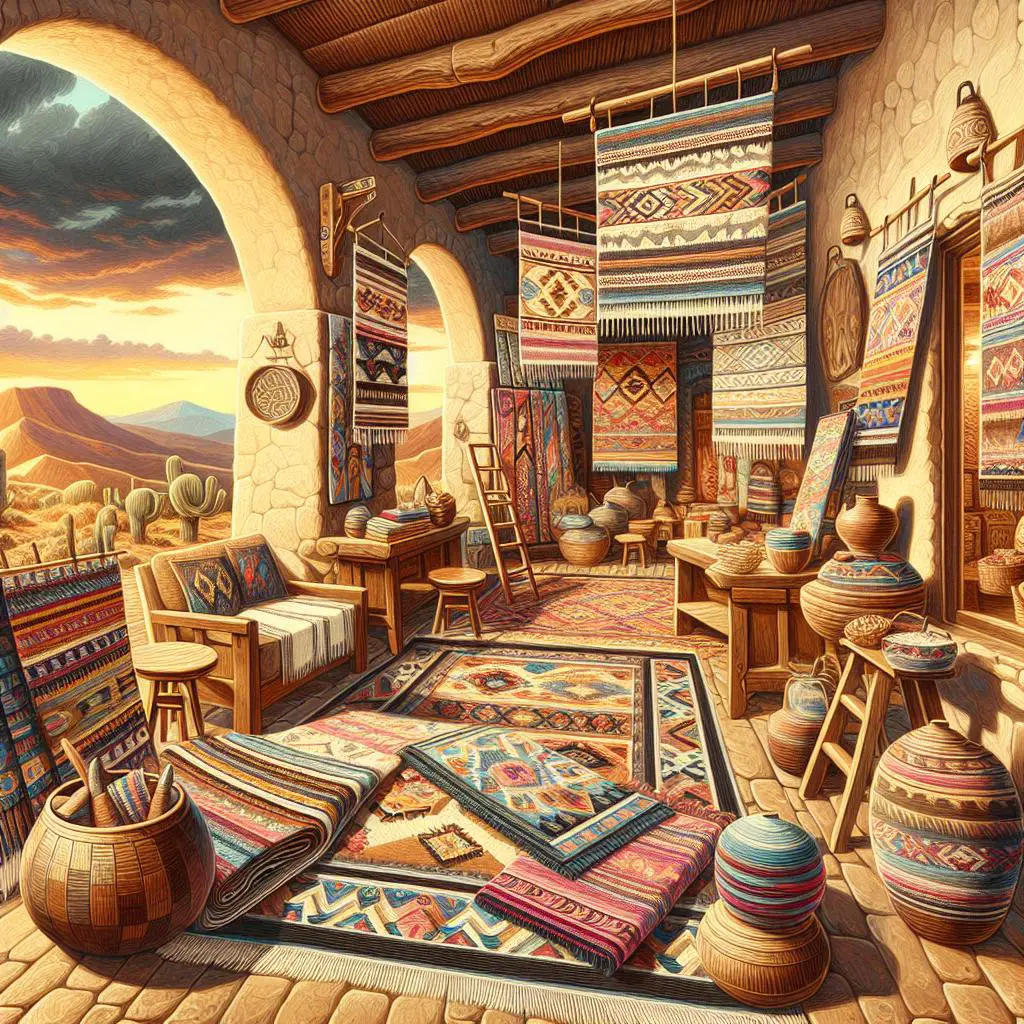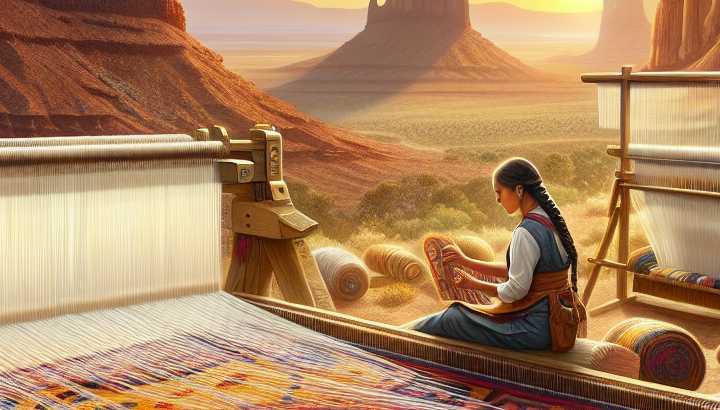Rug Weaving Techniques of the Southwest

Traditional rug weaving materials in the Southwest
Think you know everything about traditional Southwest rug weaving materials? Think again! Get ready for a wild ride across rainbow-colored woolen warp and weft, let’s face it, they’re more interesting than any drama playing out on the big screen these days.
The legendary rug-making tradition of the Southwest doesn’t just roll out a welcome mat; it tells a story, sings a melody, and does the cha-cha on a weaver’s loom. And the stars of this flamboyant performance? None other than good old Mother Nature’s showstoppers- wool, cotton, and plant dyes.
Once upon a time, Navajo shepherds, hailed as the maestros of this age-old craft, would watch their fluffy little charges frolic across the arid landscapes, blissfully unaware that their woolen coats were destined for grander pastures than grassy hillocks.
Let’s talk about wool, which is to a rug as cheese is to a pizza. It’s not just a superstar ingredient, but actually plays several roles. It’s the Shia LaBeouf of rug materials, in the lead role yet also debuting as screenwriter, producer, and director. Wool comes from our bleating friends, the sheep, which are shorn annually, not just to make them look cool for the summer, but because their fluffy coats were destined for a Bali-worthy transformation inside the magical hands of the indigenous weavers.
Homespun, naturally dyed, and incredibly resilient—woolen yarns are the Jenner-Kardashians of the weaving world. They hold the fort, carrying forward designs and patterns, mapped out in the weaver’s mind, into an intricate dance on the warp and weft, all the while looking fabulous.
“Fraternia lies in a valley among the foothills of southwestern North Carolina”
~ Caroline Atwater
Mason, Yesterday
Just like a seasoned supermodel, wool knows how to work the runway (or shall we say, loom-way), never faltering or stumbling, creating exquisite geometric patterns and motifs that have art enthusiasts swooning all over them like love-struck teenagers.
And what about cotton, you ask? Cotton is like the trusty best friend who’s there when needed, providing a reliable, strong, and resilient warp thread that sets the stage for wool to do its eccentric dance. Cotton may not get as much of the limelight, but it’s the Darcy to wool’s Elizabeth, the Holmes to its Watson—the ever-dependable companion, without whom the whole operation is, simply put, a rug without a snug.
Finally, let’s take a moment to appreciate the beautiful, natural dyes used to breathe color into these woven dreams. Plant dyes are the Vincent van Gogh of the Southwest weaving tradition, painting the designs with flamboyant strokes of indigo blues, madder reds, sunflower yellows, pinion pinks, and sumac blacks. The plant dye extracts the unseen beauty of the desert and presents it in ‘high definition’ on the woolen canvas.
In conclusion, it’s not just weaving; it’s a crazy night out in Vegas with wool letting its hair down, cotton holding everything together (and possibly the designated driver), and the plant dyes spilling the wine and setting the whole party ablaze. That my friends is the razzle-dazzle of traditional Southwest rug weaving materials!
So next time you find yourself gazing upon the intricate patterns and vibrant hues of a Southwest rug, spare a thought for the humble wool, the capable cotton, and the plant dyes which are the life of the party, and remember that they’re not just rugs, they’re woven tales celebrating the ingenuity and resilience of the Southwest’s traditional artisans.
Read More Here: Traditional Rug Weaving Materials In The Southwest

Navajo rug weaving styles and patterns
Before diving headfirst into the alluring vortex of the enchantingly complex world of Navajo rug weaving, strap on your metaphorical protective gear. You’re in for a wild, woolly, and wonderfully warp-faced ride.
Navajo weaving is no trivial matter — it’s not just an art, it’s pure magic woven into existence by the nimble fingers of mostly female Navajo weavers. Since the mid-17th century, this tribe from the Four Corners region – where Arizona, Utah, Colorado, and New Mexico play kiss-chasey – has been creating these intricate masterpieces, and if you think you can just buy a loom and some wool and whip up your own Navajo rug, you might want to think again.
Without further ado, let’s jump on the warp threads and woof our way through this spider woman’s tantalizing web of Navajo rug weaving styles and patterns.
1. Classic Period (1800-1865): The True OG
The Classic Period is where it all began. Navajo weavers were all about keeping it minimal with simple striped patterns. This was the cannabis-free ’60s, so everything was about natural earth tones—sandy beiges, russet browns, smokey greys, and midnight blacks. But don’t be fooled by simplicity; they could weave a storm into those stripes!
2. Late Classic Period (1865-1890): Sun’s out, bold hues in!
Post-1865, our Navajo artisans branched out with what I like to call the “zesty zia” effect, characterized by flamboyant reds imported from Europe. Think of it as the Navajo letting their buns down, shaking out their hair, and saying, “You know what? We’re not just about stripes. Take our serrated diamonds and stepped triangles!”
3. Rug Period (1890-1950): Make some room, it’s design galore.
Kicking off the 20th century, the Navajo weavers went weaving-wild— whipping up complex geometric patterns, symbolic representations, and yes, even the infamous eye-dazzler. It was all about being visually striking, like RuPaul sashaying onto the stage in a shimmering gown studded with disco balls.
“”There was no definite statement as to why; but from the reports it appeared that the miners were much harried by the Indians, sometimes the Navajos and sometimes the Utes, while the loss, partial or total, of two or three trains with their escorts, seemed to bring matters to a climax.””
~ Sidford F. Hamp, The Trail of The Badger
4. Pictorial Rugs (1950 onward): Who needs a canvas anymore?
From 1950 and on, the Navajo rug saw an unprecedented expansion. Canvases? Pfft, the weavers thought, and instead they started creating stunning pictorial rugs. They captured everything from their customary lifestyle to the splendid beauty of Southwestern landscapes. They even started weaving in yei figures and the utterly mind-bending sandpainting rugs. Picasso, eat your heart out!
5. Modern Navajo Weaving: Spirit of tradition in the contemporary tapestry.
Modern Navajo weaving is a delicious potpourri of all previous styles but with a contemporary twist. Today’s weavers are fearlessly experimental, blending time-honored techniques with innovative designs. Like a queen on drag night, it is all about being unique, daring, and of course, unforgettable!
There’s something you need to remember about Navajo rugs though: each rug carries a story – legends and beliefs, personal hardships and achievements, and even the weaver’s dreams. So, the next time you marvel at a Navajo rug, don’t just observe the colors and patterns, but try to listen to the whispers of the yarn.
Whether you’re in it for the art, history, or the funky geometric patterns guaranteed to cause a case of aesthetic whiplash, Navajo rug weaving has something for everyone. But beware; it’s easy to get caught in this kaleidoscopic labyrinth of ancient symbolism, bold geometrical shapes, and mind-bending motifs. So, tread carefully, not every eye-dazzler comes with a warning sign!
Source: Navajo Rug Weaving Styles And Patterns

Influence of Spanish colonialism on Southwestern rug weaving techniques
Southwestern rugs. You’ve seen them. You’ve wanted them. The mesmerizing geometric patterns, the adorable touch of vibrant colors that quietly shout, ‘Look at me, I’m pretty!’ And if you’ve ever found yourself gazing stupefied at one, held hostage by the enthralling aesthetics, you’re not alone. These rugs are real conversation stoppers. But have you ever wondered about their connection with Spanish colonialism? Let’s take a journey to find out how the Spanish influence transformed a mere utilitarian craft into a revered art form with a sense of humor as vibrant as the dyed wool in an intricate rug design.
The Spanish conquest of the Americas in the 16th and 17th centuries is a bit like your well-intentioned but didactic aunt who insists on correcting your posture at every family reunion. Her influence is profound, sometimes annoying; but on occasion, she comes with innovative approaches that shape you into a better version of yourself. In a similar vein, Spanish colonialism, often seen through critical historical lenses, brought with it foreign techniques such as wool weaving, dramatically reshaping the rug-making skills of indigenous communities of the Southwestern United States.
Before the Spanish came sailing in – like unwelcome houseguests with pushy makeovers, the Pueblo and Navajo tribes of the Southwest were happy and proficient weavers in their own right. Using cotton and plant fibers, they wove intricate baskets, mats, and sandals. Rugs? Not so much on their agenda. But boy, oh boy, did that change.
Along with their adventurous spirit and imperial enthusiasm, the Spanish conquistadors brought Churra sheep over the ocean. A game-changer, to say the least.
“Suppose (to use a colonialism) we put in an hour or two there”
~ Peter W. Barlow, Kaipara, or experiences of a settler in North New Zealand
It’s like the tribes had been writing beautiful poetry, and suddenly, the Spanish gave them an entirely new vocabulary to work with. They began working with wool, experimenting, learning, and adapting new styles of weaving brought overseas by the Spanish.
The credit also goes to the skillful Hispanic weavers who migrated northward from Mexico during the colonial period. These fellows introduced European vertical looms and treadles, becoming the metaphorical rug design influencers of the time. Subsequently, even that annoying aunt would have been impressed with the technical leap the tribes made, which went from prehistoric loom loitering to processing and dyeing wool yarns seamlessly.
Moreover, the arrival of the Spanish also meant the arrival of new patterns and designs. The indigenous tribes, known for their minimalist design predispositions, started injecting Spanish geometric and floral patterns into their work, creating a flamboyant rug fiesta!
However, don’t be fooled. Despite the Spanish influenced metamorphosis, Southwestern rug weavers maintained their original flavor. It was like making a new salsa recipe but with the same spicy kick that everyone loves. They incorporated symbols and motifs representing their beliefs, traditions, and the scenic landscapes of their ancestral home. And so, Southwestern rugs became a unique cultural blend, a metaphorical fusion cuisine of woolen artistry.
So, next time you see a Southwestern rug, remember, it’s more than just home décor. It’s the punchline of a centuries-old joke where the Spanish are the rowdy guests, wool plays the comic relief, and the indigenous tribes are both the enjoyable hosts and the skilled comedians. It’s a beautiful saga of creative amalgamation where Spanish colonial influence bought a transatlantic ticket for southwestern rug weaving techniques, making them reach to the art forms we admire today. With humor, color, and history entwined in its warp and weft, a Southwestern rug is far less a floor cover and more a monologue of diversity – and it’s telling a joke you definitely want to be let in on. So, sit back, admire the craftsmanship, and most importantly, laugh along!
Learn More Here: Influence Of Spanish Colonialism On Southwestern Rug Weaving Techniques
